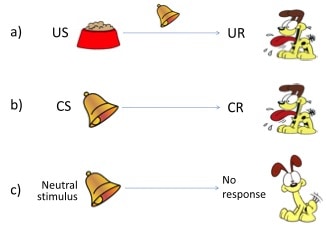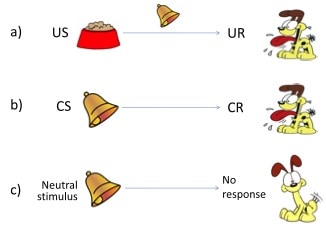As we have discussed in part 1 and 2 of this series of posts, there is some evidence that classical conditioned responses play a role in chronic pain (Flor and Birbaumer 1994; Schneider, Palomba et al. 2004; Klinger, Matter et al. 2010). We have discussed the work of Flor and others showing that injury response systems (such as motor and autonomic) can be reflexly linked to previously unrelated stimuli, and that prolonged activation of these systems may maintain the cycle of nociception and contribute to chronic pain. Further to this we have presented a case for a “classically conditioned pain output”, whereby frequent pairing of previously insignificant stimulus with a pain output (or ‘neurotag’), comes to reflexly link stimulus and pain.
That is, neural circuits associated with a sensory pain experience may become so practiced at activating simultaneously with a particular movement or context, that the movement or context alone (even without underlying pathology or nociception) may come to elicit a real sensory pain experience.
I think this is pretty bold, however if we put a pain in the same league as anxiety disorders (where any number of harmless stimuli may come to elicit an anxiety attack through its previous conscious or subconscious association with a threatening event), then the idea seems less far-fetched. Here’s what I can find out so far about helping our patients “unlearn” these associations.
Can you unlearn a classically conditioned response?
The bad news? You can’t truly unlearn something…… otherwise relapse phenomena such as “spontaneous recovery” (Alvarado, Jara, Vila, & Rosas 2006) and “renewal” (e.g. Rosas, Vila, Lugo & Lopez 2001) could not occur. The good news? New associative learning can be inhibitory or preferenced over old learning! (Bouton and Moody 2004).
Then how do you inhibit a memory?
Well you simply create a new memory trace that contradicts the old one…. and repeat it enough times so that it sticks (while avoiding reinforcing the old memory!!). Simple huh? In the traditional experimental sense this means to repeatedly expose the subject to the conditioned stimulus (i.e. the bell in Pavlov’s experiments) in the absence of the unconditioned stimulus (i.e. the food) until the bell (conditioned stimulus) no longer causes an automatic response (i.e. salivation). This has sometimes been called “extinction learning”.
Figure 1 shows a) the development of a conditioned response (CR) through repeated paring of an unconditioned stimulus (US) and unconditioned response (UR), b) shows the CR (bell) reflexly linked to the CS (salivation) and c) shows “extinction” of the learned response through repeated exposure of the CS in the absence of the US.
Extinction learning as therapy
As you know from previous posts, I am having somewhat of an “intellectual fling” with the work of the lovely Herta Flor. Thus I’m going to give special mention a couple of treatments advocated in her excellent book “Chronic Pain: an integrated bio-behavioural approach” (2011) and that are also easily relatable to classically conditioning.
Operant behavioural therapy aims to alter unhelpful behaviours that may be maintaining the problem, such as learned avoidance (Flor 2011). How does operant conditioning therapy extinguish a classically conditioned response you ask? Well, for the classically conditioned responses to be extinguished, there must be frequent exposure to the conditioned stimulus (e.g. a movement) in the absence of reinforcing stimuli. Without behavioural change away from too little (avoidance) or too much exposure (‘boom busting’) the conditions for extinction may never be met.
Biofeedback aims alter conditioned physiological responses by learning conscious awareness and control. In time the repeated conscious inhibition of the response will enable its association with the stimulus to be weakened. These tools include electromyography (EMG) and electroencephalography (EEG).
Cognitive behavioural therapy in addition to targeting behaviours also targets…..you guessed it! Cognitions! Various strategies are used to identify and target unhelpful thoughts and beliefs that may contribute to physiological responses and prevent new learning.
Do these treatments reduce pain?
In 2008, Ostelo and van Tulder published a Cochrane review on behavioural therapy for chronic back pain. They stated that “they did not expect to find improvements in pain” rather they expected to find improvements in other measures of behaviour, and pain experience. To their surprise there was clear evidence for improvements in pain with these therapies! However! they could not explain the mechanism.
What does Herta Flor say?
Herta proposes (with fair rationale) in her excellent book (2011) that these treatments work via one or more of the following:
- Reduction in the sensitising effect of fear, anxiety and depression
- Improved self-efficacy
- Improved physical conditioning
- Reduction in nociceptive inducing muscle tone and sympathetic output….
Though, despite scouring Herta’s book (Flor and Turk 2011), I found barely a hint of the “classically conditioned pain output” idea which I think may have something to do with it as well.
Clinical note
It is clear that there is power in exposing patients to the environment, movement or context that is associated with their problem. The message of classical conditioning theory is…. that it needs to be done in such a way as to contradict the previous association. THUS it is not wise to put patients in at the deep end where the associations will be strengthened. Rather, by using clever thoughtful systems such Graded Exposure or Graded Motor Imagery (have a look at the new whiz-bang book – The Graded Motor Imagery Handbook), neural pathways associated with a context can be exercised without activating the neural pathways associated with the response systems. Thus, weakening the link.
On a more hypothetical note, it is worth considering that during or after treatments where a normally painful movement or activity is completely (and romantically) pain free, (whether by Mulligan mobilisations with movement, Feldenkrais movement tricks, Maitland mobilisation, elbow in the Quadratus Lumborum or a cortisone and anaesthetic injections) there may be an opportunity to expose our clients to the movements and contexts (conditioned stimuli) without reinforcing the pain association in order to induce extinction learning.
Some food for thought. And for my PhD it seems….
About Daniel Harvie
 Daniel is a recently commenced PhD candidate in the Body in Mind Research Group at UniSA. He has a clinical physiotherapy background and is a graduate of the Master of Musculoskeletal and Sports degree at the University of South Australia. His research will look at the application of learning models to the development and extinction of chronic pain.
Daniel is a recently commenced PhD candidate in the Body in Mind Research Group at UniSA. He has a clinical physiotherapy background and is a graduate of the Master of Musculoskeletal and Sports degree at the University of South Australia. His research will look at the application of learning models to the development and extinction of chronic pain.
He enjoys writing and recording music, hasn’t had a car for 3 months (an experiment) and has a bionic knee.
References
Bouton ME, & Moody EW (2004). Memory processes in classical conditioning. Neuroscience and biobehavioral reviews, 28 (7), 663-74 PMID: 15555676
Flor, H., & Birbaumer, N. (1994). Acquisition of chronic pain APS Journal, 3 (2), 119-127 DOI: 10.1016/S1058-9139(05)80339-0.
Flor, H. and D. C. Turk (2011). Chronic pain: an intergrated biobehavioral approach. Seattle, IASP press.
Klinger R, Matter N, Kothe R, Dahme B, Hofmann UG, & Krug F (2010). Unconditioned and conditioned muscular responses in patients with chronic back pain and chronic tension-type headaches and in healthy controls. Pain, 150 (1), 66-74 PMID: 20452731
Schneider C, Palomba D, & Flor H (2004). Pavlovian conditioning of muscular responses in chronic pain patients: central and peripheral correlates. Pain, 112 (3), 239-47 PMID: 15561378




